This brochure on the Fund's historic building was published in 1987.
INTRODUCTION
This landmark building at One East Seventy-Fifth Street is an architectural treasure of New York City, as beautiful architecture is to be cherished in every city. The building was designed with taste and restraint as the home of Edward and Mary Harkness, who contributed so widely to the nation's art, educational and health institutions. On the death of Mrs. Harkness, the building was left to The Commonwealth Fund, which the family had established in 1918. Since 1952, Harkness House has been the Fund's home, as well as its responsibility. The directors and staff of the Fund regard the preservation of Harkness House as one of their prime charges. Although works of art that adorned the house when Edward and Mary Harkness lived here have gone for the public's benefit to the Metropolitan Museum of Art, a few blocks north of Fifth Avenue, the integrity of the building has been maintained. And because an exceptional structure like Harkness House seems to interest many New Yorkers and visitors to the city, we have prepared this brochure to tell its story. It is a story of a time of gracious living and of a city that was just entering the century we shall soon be leaving. Harkness House is a legacy of that time and as such deserves our affection and attention.
Margaret E. Mahoney
President
The Commonwealth Fund, 1980–1994
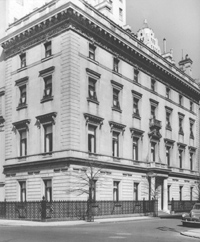 Most photographs on this page were made during the years that the Harkness family lived in the house. Harkness House (left) was photographed shortly after it was completed in 1908. Its façade of Tennessee marble displays the classical forms of the Italian Renaissance.
Most photographs on this page were made during the years that the Harkness family lived in the house. Harkness House (left) was photographed shortly after it was completed in 1908. Its façade of Tennessee marble displays the classical forms of the Italian Renaissance.
HARKNESS HOUSE
Paul Goldberger
Harkness House is a notable presence on the cityscape of New York. The outside of One East Seventy-Fifth Street today looks virtually as it did in 1908, when Edward and Mary Harkness moved in. Although the house has not functioned as a private residence for more than three decades, inside it retains even more of the ambiance of Fifth Avenue's great houses than do mansions better known to the public, such as the Frick Collection and the Cooper-Hewitt Museum.
But Harkness House is remarkable not merely as a survivor. Early in the century, when the house was new and the blocks of Fifth Avenue opposite Central Park were becoming filled with the great houses of the rich, architect James Gamble Rogers' design for Harkness House stood out as unusually strong and dignified. It was a period in which the architecture of great houses along Fifth Avenue seemed to celebrate extravagance far more than restraint. Just before Harkness House was built, the architects Hewlett & Hull completed a residence two blocks to the north for Senator William Clark, who had made a fortune in Montana copper mining, that was perhaps the most lavish house ever built in New York, a wildly Baroque exaggeration of French Beaux-Arts architecture. If Harkness House's other neighbors were a bit less elaborate, as a group the houses of this district emanated ostentation.
To all of this, James Gamble Rogers, the Harkness family's architect, responded with a building of somber and self-assured power. The French style that had inspired the Clark mansion clearly held little appeal for Edward S. Harkness and James Gamble Rogers. They turned instead toward the more restrained forms of the Italian Renaissance.
Harkness House has a blend of qualities that make it almost metaphoric of New York itself. It is an unusually disciplined design, rigorous, precise and not, at least from the outside, immediately welcoming to those who do not know the way. But it is far from cold: It is inventive in its use of form, with just below that solid surface a lushness that is scintillating. Here is a sense both of controlled order and strong, creative energy—a mix very much like the city itself.
This house is best understood by a look at the people who built it and the time in which it was made. New York in the first decade of the 20th century was a city aware of its growing role as an international center of business and finance and increasingly eager to assert itself as a cultural force as well. But if there was great self-confidence in the city's economic power, there was relatively little of it in the arts. At the time Harkness House was built, most of the architecture in New York was heavily derivative of European, and particularly classical, models. The aspirations of the city were such that its architects, not to mention their clients, tended to look most often to Europe for inspiration or, at the very least, for confirmation of their taste—seeking, in a sense, to use their affluence to import culture from the places New York was hoping to supplant.
On the whole, the great houses of New York in these years tended to be an eclectic mix, bits and pieces of history put together by the architect's instinct into a new composition. James Gamble Rogers was an architect who relied heavily on historical style; but what guided him even more were his powerful sense of proportion, his gift of composition and his strong understanding of the appropriateness of a particular design to a particular place.
The Architect and The Client
Rogers was an intuitive designer in the very best sense. When he combined elements, it was not only to evoke a cultural association with the past but also to create a form that made visual sense on its own terms. His Gothic buildings at Yale University (most of which were commissioned by Edward S. Harkness after Harkness House was built) are good examples.
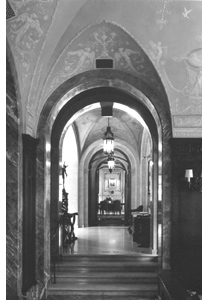 Rogers, who had been born in Louisville, raised in Chicago and graduated from Yale in 1889, displayed a mix of esthetics and pragmatics throughout his life. In his early years as an architect in Chicago, he associated casually with Frank Lloyd Wright; but he was distinctly uncomfortable with modern architecture—in part, perhaps, because he sensed that there was no great support for it among the well-to-do who were his potential clients.
Rogers, who had been born in Louisville, raised in Chicago and graduated from Yale in 1889, displayed a mix of esthetics and pragmatics throughout his life. In his early years as an architect in Chicago, he associated casually with Frank Lloyd Wright; but he was distinctly uncomfortable with modern architecture—in part, perhaps, because he sensed that there was no great support for it among the well-to-do who were his potential clients.
Rogers was never an esthetic innovator. He considered himself a part of the social class from which he drew his clients, and he accepted rather than challenged those clients' stylistic preferences.
In 1904, Rogers came to New York and formed a brief partnership with Herbert D. Hale. Still relatively young and unknown in New York, Rogers was selected to design Harkness House, a commission that would, in many ways, prove a turning point in his life, for its success would lead Edward S. Harkness to provide Rogers with work for the rest of his career.
Theirs was an unusually comfortable architect-client relationship. Edward Harkness, an heir to a major portion of the Standard Oil fortune, was born in 1874, the youngest of four children of Stephen V. Harkness, an Ohio businessman who had been an early investor in John D. Rockefeller's Standard Oil Company. Edward Harkness was graduated from Yale in 1897 and settled in New York to help manage his family's business interests. He was a shy man and earnestly sought privacy, if not anonymity. With his wife, the former Mary Stillman, whom he married in 1904, he devoted most of his adult life to the philanthropic efforts of The Commonwealth Fund, a foundation that his mother, Anna M. Harkness, formed and to which he also contributed substantially.
The style of Edward Harkness' life was grand but highly private and understated in proportion to his wealth. So Rogers could design an elaborate building for Harkness, but with the restraint that was an inherent characteristic of all his buildings. Indeed, so similar do the instincts of both men appear to be that, in the absence of documentation, it seems logical to presume that both were responsible for basic design decisions about Harkness House—for example, that the overall style be the somewhat formal Italian Renaissance. And it seems revealing that the main public space at Harkness House was given over, not to a ballroom, but to a library and a music room.
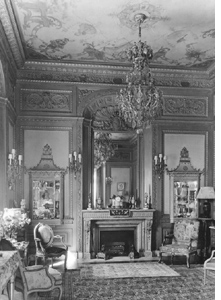 Despite the Harkness family's willingness to spend amply—the house was a wedding gift from Anna Harkness, then a widow, to her son and daughter-in-law—Rogers was not able to design with a completely free hand. The greatest constraint he faced was surely that of space. The site at the northeast corner of Fifth Avenue and Seventy-Fifth Street was an unusually tight one, even for New York, running one hundred feet along Seventy-Fifth Street but with only thirty-two feet of frontage on Fifth Avenue.
Despite the Harkness family's willingness to spend amply—the house was a wedding gift from Anna Harkness, then a widow, to her son and daughter-in-law—Rogers was not able to design with a completely free hand. The greatest constraint he faced was surely that of space. The site at the northeast corner of Fifth Avenue and Seventy-Fifth Street was an unusually tight one, even for New York, running one hundred feet along Seventy-Fifth Street but with only thirty-two feet of frontage on Fifth Avenue.
The Harknesses required that, in addition to public rooms, the house include seven main bedrooms, fourteen servants' bedrooms, and numerous kitchens, pantries, workshops, storerooms and mechanical rooms. And it was in the nature of any Fifth Avenue mansion, even one for a man of Edward S. Harkness' unpretentious temperament, that the main rooms be large.
The Organization of the House
Fitting in everything was a challenge that Rogers met superbly. The key to the organization of the house was the decision to place the entrance on Seventy-Fifth Street, rather than on Fifth Avenue, instantly turning the house from what would have been a narrow, very deep townhouse into a wide, but not particularly deep mansion. This shift also made it logical to give the house an understated Seventy-Fifth Street address instead of a more showy Fifth Avenue one—something that was consistent with Harkness' dislike of overt ostentation. (Indeed Harkness persuaded his neighbors to the east, the occupants of a house designed by C. P. H. Gilbert and built in 1904, to turn over to him their house number of One East Seventy-Fifth Street. The Gilbert house, which still stands, became Three East Seventy-Fifth Street.)
Harkness House's façade of Tennessee marble is a masterwork of composition, a reminder of how a talented architect can work within an existing vocabulary—in this case, the classical forms of the Italian Renaissance—and still indulge in considerable creativity. Rogers' solution for the restrictions of the site required seven floors, five above ground and two below, far too many to make a well-proportioned building on this piece of land. Therefore, Rogers turned the top floor, which contained servants' rooms, into a penthouse, setting it back and surrounding it with an ornate, carved-stone balustrade, so that from the street, the house appears to have only four floors.
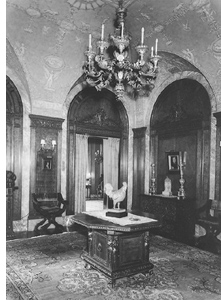 The stone balustrade and the ornate cornice just below it—itself the richest piece of exterior ornamentation by far—also enhance the sense of horizontality that was important to the Italian Renaissance inspirations of the design. Maintaining a horizontal emphasis in a house that is tall and narrow is not easy, but Rogers skillfully placed virtually all of the elements of the façade at the service of this goal. At the base, the elaborate wrought-iron fence, inspired by the fence of the Scalegari tombs in Verona, acts as a counterpoint to the cornice and balustrade, echoing their horizontal stream of intricate pattern. Behind the fence, the street floor is faced in rusticated stone, topped by a small cornice and balustrade, a combination of elements that further emphasizes the horizontal line. Elaborate lintels over the windows, and a narrow ornamental string course below the fourth-floor windows, do still more.
The stone balustrade and the ornate cornice just below it—itself the richest piece of exterior ornamentation by far—also enhance the sense of horizontality that was important to the Italian Renaissance inspirations of the design. Maintaining a horizontal emphasis in a house that is tall and narrow is not easy, but Rogers skillfully placed virtually all of the elements of the façade at the service of this goal. At the base, the elaborate wrought-iron fence, inspired by the fence of the Scalegari tombs in Verona, acts as a counterpoint to the cornice and balustrade, echoing their horizontal stream of intricate pattern. Behind the fence, the street floor is faced in rusticated stone, topped by a small cornice and balustrade, a combination of elements that further emphasizes the horizontal line. Elaborate lintels over the windows, and a narrow ornamental string course below the fourth-floor windows, do still more.
More subtle is what Rogers chose not to do. There are what might be called pseudo-pilasters between the windows on the street floor, in the form of capitals that have no shaft beneath, Rogers' version of a device occasionally used by Mannerist architects. By merely hinting at pilasters rather than providing them in full, Rogers avoided what would have been a counteracting verticality. Similarly, the entrance—a Tuscan portico at the central of the seven bays of the Seventy-Fifth Street façade—is strengthened by a broken pediment and scrollwork around the second-floor window above the entry portico, but not by much else, so the central axis of the house could be said to be underemphasized to avoid further competition.
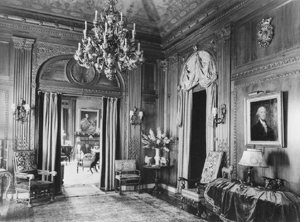 In some ways, all of this effort may have been futile, since the Fifth Avenue side of the house is so conspicuously visible and, because of its narrowness, has a sense of verticality. But even this is handled knowingly. The quoins, or rusticated stones that mark the corners, are close together on the Fifth Avenue side, creating the effort of framing this narrow façade, enclosing and controlling it. And the themes of the Seventy-Fifth Street façade continue around the corner to Fifth Avenue, assuring that, from the corner, the house reads as a coherent and total composition.
In some ways, all of this effort may have been futile, since the Fifth Avenue side of the house is so conspicuously visible and, because of its narrowness, has a sense of verticality. But even this is handled knowingly. The quoins, or rusticated stones that mark the corners, are close together on the Fifth Avenue side, creating the effort of framing this narrow façade, enclosing and controlling it. And the themes of the Seventy-Fifth Street façade continue around the corner to Fifth Avenue, assuring that, from the corner, the house reads as a coherent and total composition.
Modesty and Restraint
All of James Gamble Rogers' work, from his largest buildings to his smallest, is marked by a relatively modest scale, and this house is no exception. The entry portico, for example, is a good bit smaller than the front doors of many similar houses built at the time by other architects, and it is raised but four steps above the sidewalk. This use of relatively small elements, as much as any particular detail, might be said to have been Rogers' trademark; it certainly set him apart from such architects as McKim, Mead & White; John Russell Pope, and Carrere & Hastings, to mention some of his most important and well-known contemporaries.
This characteristic of Rogers may well have been what made most of his buildings so responsible urbanistically. Almost all of Rogers' buildings fit comfortably into their surroundings, even when their neighbors are dramatically different architecturally. The restraint in Rogers' buildings suggests a kind of deference and good manners.
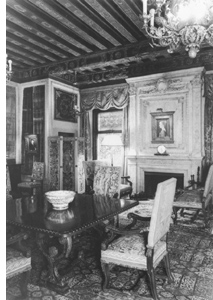 Harkness House, for all that it looks to 15th century Italy, is very much a building built for a New York City street in the 20th century. It is dense and urban and part of a larger whole. Though it reads somewhat as a solid mass from the corner, it is primarily a pair of facades addressing themselves to the street, and it welcomes other buildings beside it. It is a house that would not be comfortable as a villa, with open space flowing around it.
Harkness House, for all that it looks to 15th century Italy, is very much a building built for a New York City street in the 20th century. It is dense and urban and part of a larger whole. Though it reads somewhat as a solid mass from the corner, it is primarily a pair of facades addressing themselves to the street, and it welcomes other buildings beside it. It is a house that would not be comfortable as a villa, with open space flowing around it.
It could not be more different in this sense from one of its most distinguished neighbors, the James B. Duke House by Horace Trumbauer, finished in 1912 just three blocks uptown at One East Seventy-Eighth Street. The Duke House, now used by New York University as its Institute of Fine Arts, is somewhat larger than Harkness House, but Trumbauer's immense scale makes it appear bigger still. The windows are huge, the entry stair broad, and the house stands free, set back slightly from the street and from its neighbors. It is a great French neoclassical palace. Instead of giving off a sense of comfortable, discreet accommodation to the realities of New York, it seems to cry out to be alone amidst acres of landscape, with a long, formal approach along an allee of trees.
The impressive restraint of James gamble Rogers' design was apparent as far back as 1910, when the Architectural Record praised Harkness House as being designed in a "manner free from excess and exaggeration" and went on to note that "If there is any façade on upper Fifth Avenue which gives an effect of quiet elegance by worthier architectural means it has not been our good fortune to come across it."
"The effect of the house," the Record's critic continued, "both inside and outside, is unmistakably rich and costly, but this effect is obtained by the use of comparatively discreet and architectural meritorious means. In other words, the frank costliness of the effect of the house never even suggests mere ostentation. An intelligent and conscientious architectural purpose has given coherent form to every detail of the house and its decoration, so that the effect of mere costliness has become subordinated to a more dominant effect of architectural balance and propriety."
A Sense of Domesticity
The interior of Harkness House continues the architectural themes set on the outside—it is never overwhelming, but it could hardly be thought to represent excessive modesty, either. Once again, the scale is small, though hardly tiny, and this, combined with Rogers' tendency to use wood paneling instead of stone in the public rooms, creates a greater sense of domesticity than in many similar houses, such as the Duke House. The tightly organized floor plan is slightly unusual, and its eccentricities seem to exist to enhance the sense of domesticity that Rogers clearly sought. As on the exterior, Rogers was willing to break away from architectural conventions if it served a defensible purpose—in this case, assuring that the building, for all its grandeur, retain the feeling of a private house.
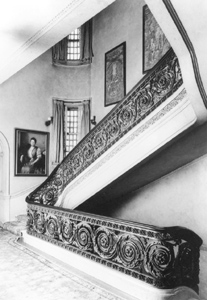 The sequence of rooms at the entry makes the point. The central door, a great mass of glass and wrought iron that swings with the solid self-assurance of a bank vault, brings us to a small vestibule with a vaulted ceiling, a marble bench and a hanging light. From here we move not straight ahead, as in most houses, but make a 90-degree turn to the left to an ornate bronze and glass door set beneath a great arched fanlight with similar bronze carving, on the other side of which is a formal entrance hall.
The sequence of rooms at the entry makes the point. The central door, a great mass of glass and wrought iron that swings with the solid self-assurance of a bank vault, brings us to a small vestibule with a vaulted ceiling, a marble bench and a hanging light. From here we move not straight ahead, as in most houses, but make a 90-degree turn to the left to an ornate bronze and glass door set beneath a great arched fanlight with similar bronze carving, on the other side of which is a formal entrance hall.
Although the turn has another purpose—to prevent us from entering right into the raised stair landing, which was placed directly behind the small vestibule—it has the happy effect of making the movement through this sequence of spaces feel less grand and formal. This floor plan was not Rogers' original one; he first intended that the entrance hall would be entered directly, rather than with the 90-degree turn, an arrangement that presumably was rejected by the Harknesses. The present layout is similar to one that Rogers used in a less formal house in Chicago, and it seems a reasonable assumption that the Harknesses found the original plan with its formal axis too imposing.
The vestibule's vaulted ceiling, which is now of Escallion, a polished limestone from France that is similar in appearance to marble, was originally made of ornamental glass depicting a floral trellis. It was altered by Rogers sometime after 1920. The walls are of Boticino limestone, an Italian polished stone that is also similar in appearance to marble.
The entrance hall itself is a square room, also with a vaulted ceiling, its walls an unusual mix of brown Formosa, another polished limestone, and veneered oak. The combination probably was intended to provide a transition between the stone of the outside and the vestibule and the more extensive use of wood further inside the house.
Here, Rogers was particularly inventive in his design of details. The baseboards are of stone, from which spring stone columns and arches; set between them are panels of oak which contain rich carving that helps form a base for the delicate, almost Adamesque carving of the vaulted plaster ceiling. The room demonstrates Rogers' gift for balance at its best; it is delicate, almost lyrical, yet it is solid and enclosing as well.
Beyond the entrance hall is the room originally used as a reception room; it is now a conference room. It was once entered through a wide double door, which was eliminated in one of the few structural changes made to the lower floors of the house when it became the home of The Commonwealth Fund early in 1952. Opposite the door is a freestanding, painted leather screen described in an inventory of the house's contents as being "in the Persian style." The mood in this room is more formal than in many of the other interior spaces.
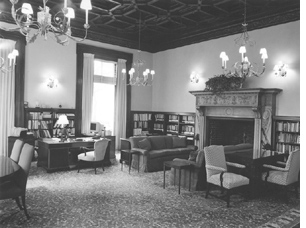 Long ago, the Harknesses used this room to receive guests before proceeding to dinner. After Edward Harkness' death, Mrs. Harkness preferred to receive guests upstairs. The tone here is more French than Italian, with walnut paneling on the walls, rococo niches, a ceiling painted in the chinoiserie style popular in 18th-century France, and particularly pleasing recessed arches over the windows. The ceiling motifs mix Oriental and Western images, with Chinese men and monkeys and Caucasian ladies with parasols.
Long ago, the Harknesses used this room to receive guests before proceeding to dinner. After Edward Harkness' death, Mrs. Harkness preferred to receive guests upstairs. The tone here is more French than Italian, with walnut paneling on the walls, rococo niches, a ceiling painted in the chinoiserie style popular in 18th-century France, and particularly pleasing recessed arches over the windows. The ceiling motifs mix Oriental and Western images, with Chinese men and monkeys and Caucasian ladies with parasols.
The fireplace, though consistent with French Renaissance precedent, is particularly characteristic of Rogers. It is small for such a grand room, but the surrounding detail skillfully makes the transition from its own very small scale to the room's medium scale. The wall panels were originally intended for pictures, as early photographs show, and thus the wall sconces were placed at the outer edges of the panels, almost pushing into the window frames—an unusual place for them, and clearly Rogers' way of attempting to rework convention to serve a functional need.
The French Renaissance style of the reception room is continued in the ladies' dressing room, a small, boudoir-like space which was gilded and lined with mirrors. The custom dressing table and coat rack and the coved, plaster ceiling add to the sense of this tiny room as an ornate and lighthearted element within the overall fabric of the house.
Across the entrance hall from the reception room, the floor level rises by four steps to a marble stair landing. Straight beyond it, at the far east end of the street floor, is the dining room, set on the same raised level as the landing. The dining room, which now serves as The Commonwealth Fund boardroom, is thus, in effect, raised on a platform, permitting easy views to the street from the table and increasing the intimacy of the room by reducing the ceiling height. The ceiling of this room, which is inspired by Venetian Renaissance precedent, is intricately coffered with small beams, richly polychromed and covered with gilded rosettes of plaster of paris. The spaces between the beams are decorated in a design of gilded entwined lines on a blue background.
Once again, there is an unusually small fireplace, barely larger than the type one would expect to find in an average apartment, but brought up to the scale of the room by elaborate surrounding pilasters, cornices and pediments. The windows on the long wall of the dining room, which is blocked by the nearby wall of the adjoining house, are of leaded glass, designed by the celebrated muralist Kenyon Cox. The windows depict classical women; their themes are "Abundantia Maris" and "Abundantia Terrae"—abundance of the sea and earth.
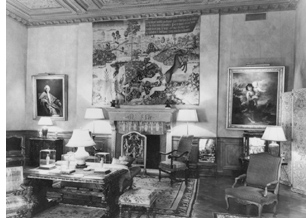 This room still contains the Harknesses' original dining table, as well as portraits of family members. Anna M. Harkness is over the fireplace, Mary Stillman Harkness on the south wall and Edward S. Harkness at the south end of the west wall. A portrait of Malcolm P. Aldrich, who succeeded Edward S. Harkness as president of The Commonwealth Fund, is at the north end of the west wall.
This room still contains the Harknesses' original dining table, as well as portraits of family members. Anna M. Harkness is over the fireplace, Mary Stillman Harkness on the south wall and Edward S. Harkness at the south end of the west wall. A portrait of Malcolm P. Aldrich, who succeeded Edward S. Harkness as president of The Commonwealth Fund, is at the north end of the west wall.
The Design Upstairs
The main staircase is constructed entirely of Cassis marble, actually a polished limestone, with a continuous balustrade of cast bronze running from the first floor to the fourth. Set within a stair hall of Istrian marble, another polished limestone, the stair is large and oblong shaped, with rounded ends. It flows graciously upward through the house, but its positioning is unusual. It is not a natural focal point. Its treads and risers and balustrades do not dominate the view from the entry hall as in so many great houses. The stair hall is set back somewhat from the main rooms of the house, particularly on the upper floors, where it is enclosed, almost in the manner of a modern stair.
The second floor is the true piano nobile of this house, a main level raised high above the street. The rooms are larger and the scale more generous than on the street floor, although Rogers' characteristic reluctance to let any single element be too large still remains, so the rooms never lose a domestic feeling. The floor contains three public rooms—a long central gallery, onto which the stair hall opens and which runs parallel to Seventy-Fifth Street; the library, a roughly square-shaped room at the west end; and the music room, a similarly square-shaped room balancing the library, at the east end.
The gallery is more than a connection or a corridor; it is a room in itself, virtually as large as the salons at each end and more elaborately detailed. Its special characteristics burst upon the visitor suddenly, for the gallery is separated by a small, relatively plain set of double doors from the enclosed stair hall, so there is no hint, on approach, of what is within. (Originally, there was a larger entrance; the pocket doors were removed in the conversion of the house into offices.)
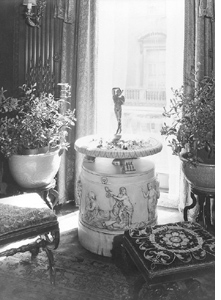 Those doors open on the gallery, which the Architectural Record called "perhaps the most beautiful room in the house." With its gently vaulted ceiling and rich walnut paneling, it is lush, almost sensual. The ceiling is painted with a mix of Greek and Pompeiian images, including putti, griffins and winged humans in soft red, green and blue on a tan background. The long walls are divided into five bays, each separated by pilasters with highly stylized Corinthian capitals. The detailing here is particularly inventive: Carved groups of leaves climb up the fluting of the pilasters, and at the top, the lionheads within the capitals of the pilasters have medallions marked with the letter H suspended from their necks. A fountain, carved of Carrara marble with low relief sculpture and topped by a bronze figurine of Pan holding a lion cub, is in the middle before the central window.
Those doors open on the gallery, which the Architectural Record called "perhaps the most beautiful room in the house." With its gently vaulted ceiling and rich walnut paneling, it is lush, almost sensual. The ceiling is painted with a mix of Greek and Pompeiian images, including putti, griffins and winged humans in soft red, green and blue on a tan background. The long walls are divided into five bays, each separated by pilasters with highly stylized Corinthian capitals. The detailing here is particularly inventive: Carved groups of leaves climb up the fluting of the pilasters, and at the top, the lionheads within the capitals of the pilasters have medallions marked with the letter H suspended from their necks. A fountain, carved of Carrara marble with low relief sculpture and topped by a bronze figurine of Pan holding a lion cub, is in the middle before the central window.
The gallery now holds desks for employees who assist two of The Commonwealth Fund's chief executives, who occupy the library and music room as their offices. Though the change in function here is dramatic—it is striking indeed to see computer terminals against the backdrop of Rogers' carved wood paneling—the integrity of the room as a work of architecture is not seriously compromised by this accommodation.
The rosewood-paneled library, which now serves as the office of the president of The Commonwealth Fund, faces Fifth Avenue. Though the fireplace here is quite large, unlike the others in the house, except for an even larger fireplace in the music room, the library on balance is a more reserved room than the gallery. The deeply coffered, Brazilian rosewood ceiling, with its complex, Italian Renaissance–inspired pattern of interlocking squares and octagons, is the most notable exception, the one element here that suggests the degree of richness, if not of delicacy, that the gallery possesses. Rogers had more elaborate ideas for this room, however—sockets for light bulbs were placed at the intersections of the beams in the ceiling, an inventive experimentation with electric light that had the advantage of enhancing the architectural form of the ceiling rather than obscuring it, as a conventional chandelier would have done. Although photographs from 1910 show the room lit with electric bulbs in these sockets, this lighting system was abandoned, perhaps because of the difficulty of maintaining so many separate bulbs.
The music room, designed for recitals, was originally the more ornate of the two second-floor salons, with four chandeliers and elaborate Corinthian-column adorned woodwork. The room was considerably renovated in 1920, for reasons that have not been recorded, at which time a substantial amount of architectural detail was removed. The renovated room, now the office of the senior vice president of The Commonwealth Fund, is early Italian Renaissance in inspiration, with a simpler, almost primitive quality.
The paneled ceiling, with a pattern of ovals and squares, is Venetian in spirit. It is one of the few elements remaining from the room's original design. A decorative floral frieze beneath the ceiling was taken down, as were the original chimneypiece, the chandeliers and the wall panels. The false Tuscan doors on the west wall, which are roughly symmetrical to the doors opening into the gallery, were added at the time of the renovation, while the iron doors over the east windows, with painted, chinoiserie glass panels, believed to be by Kenyon Cox, are original.
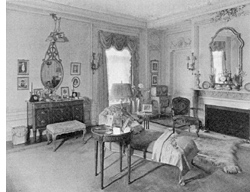 The high ceiling of the second floor requires the stair to make a double turn to reach the third floor; an intermediate landing gives onto a tiny mezzanine containing only storerooms. On the third floor were the Harknesses' private quarters, some rooms of which have now been divided into smaller offices. The rooms were once again relatively small on this floor, and even the most elaborate and most appealing, Mrs. Harkness' boudoir, a lovely, soft green room with rounded corners, a marble fireplace and a gracious view over the trees into Central Park, is not large. Happily, this room remains intact today, as the office of the Fund's vice president and treasurer. The boudoir and Mrs. Harkness' bath took up the entire Fifth Avenue frontage; the Harknesses' sleeping quarters, also generally French in decoration, faced Seventy-Fifth Street.
The high ceiling of the second floor requires the stair to make a double turn to reach the third floor; an intermediate landing gives onto a tiny mezzanine containing only storerooms. On the third floor were the Harknesses' private quarters, some rooms of which have now been divided into smaller offices. The rooms were once again relatively small on this floor, and even the most elaborate and most appealing, Mrs. Harkness' boudoir, a lovely, soft green room with rounded corners, a marble fireplace and a gracious view over the trees into Central Park, is not large. Happily, this room remains intact today, as the office of the Fund's vice president and treasurer. The boudoir and Mrs. Harkness' bath took up the entire Fifth Avenue frontage; the Harknesses' sleeping quarters, also generally French in decoration, faced Seventy-Fifth Street.
Five guest bedrooms, a sewing room and a room for a valet were on the fourth floor, while the fifth, or penthouse floor, which was accessible by a separate servant's stair, was given over to maids' bedrooms and the laundry, which was operated only by female servants. The elaborate kitchens, with white tile walls and white ash woodwork, the wine cellar, and bedrooms for male servants were in the basement, with boilers and storerooms in a cellar one more level down.
The Harkness Family, Still
Mrs. Harkness continued to occupy the house for the decade following her husband's death, until her own death on June 6, 1950. The Harknesses left no heirs; and at the time of Mary Stillman Harkness' death, the furnishings and art collection within the house, which included paintings by Holbein, Thomas Gainsborough and Gilbert Stuart, were bequeathed to the Metropolitan Museum of Art, and the house itself was turned over to The Commonwealth Fund, which has occupied it since early 1952.
One East Seventy-Fifth Street has not only escaped the sad fate of demolition that has overtaken so many of its neighbors on Fifth Avenue—it has never, in a sense, left the Harkness family. It remains in the hands of the family's foundation, which continues to maintain it with care and respect—recognizing that the preservation of one of New York City's most distinguished houses can, in and of itself, be a philanthropic gesture that enriches the quality of life for the entire city.
THE AUTHOR
Paul Goldberger is the senior architecture critic of the New York Times. He has been awarded the Pulitzer Prize for Distinguished Criticism and the medal of the American Institute of Architects. He joined the Times after graduating from Yale (also Edward S. Harkness' alma mater), where, coincidentally, he wrote his senior essay on John Gamble Rogers, the architect of Harkness House. Goldberger writes frequently about architecture, design and issues of urban planning and historical preservation. He is the author of four books: The City Observed—New York: An Architectural Guide to Manhattan; The Skyscraper; On the Rise: Architecture and Design in a Post-Modern Age, and Houses of the Hamptons. In the research of the interior of Harkness House, Paul Goldberger was skillfully assisted by architectural historian Erin Gray.


